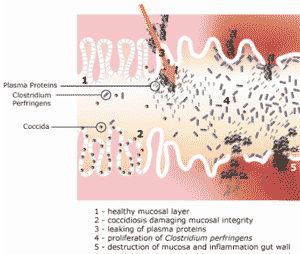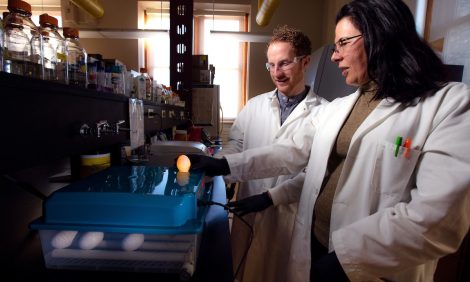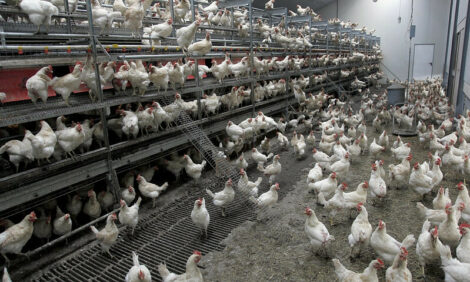



Better Gut Health Enhances Animal Performance
The health of the gastrointestinal tract is especially important for the young animal, writes Nataliya Roth, Technical Manager with Biomin Holding GmbH.There are several possibilities to influence gut health, and feed additives such as probiotics, plants extracts, acids etc. are among the options available to the animal production. Of these feed additives, one possibility is butyric acid. In Nature, butyric acid glycerides are found in the milk of cows, sows and other species. Butyric acid is produced in the large intestine of monogastric animals or in the rumen of ruminants due to microbial degradation of carbohydrates. However, there is no naturally produced butyric acid found in the small intestine.
There are several products on the market providing salts of butyric acid in protected and unprotected forms. Due to the unpleasant persistent odour of butyric acid, protection makes the handling of the product easier. Another reason for protection is to obtain stomach by-pass of butyric acid and subsequent release of the active substance in the small intestine. Encapsulation of acids is a known form of protection. There is also an innovative, beneficial protection in a form of glycerides, which is the combination of acids and glycerol. The glycerol-acid compound is not influenced by the pH of the stomach; therefore these compounds reach the small intestine where the gradual release of the undissociated acids through the action of lipases takes place.
It is known that protected butyric acid is an excellent growth promoter as it is an efficient nutrient for the intestinal mucosa increasing the density and length of villi, enlarging the adsorption surface of the intestine (Galfi and Bokori 1990). Butyric acid is also known as antibacterial agent against pathogenic microorganisms including Salmonella, Clostridium, Escherichia coli, Brachyspira etc. and as modulator of the intestinal flora supporting useful microorganisms such as lactobacilli (Galfi 1990). Butyric acid enhances the reparation of gut wall lesions caused by intestinal diseases and nutritional imbalance. Moreover, butyrate stimulates gastric secretion (Katoh and Tsudo 1984), improving protein and fat digestibility.
The combination of butyric, caprylic and capric acids in the protected glycerides form optimises the influence of butyric acid. Glycerides allow all acids to act as antibacterial in the intestine. Furthermore, caprylic and capric acids show very strong antimicrobial activity in the higher pH value (6-7) of the intestine. Moreover, glycerides containing butyric acid and medium-chain fatty acids possess nutritional qualities that are especially important for young animals. Medium-chain fatty acids – which are saturated fatty acids mainly composed of 8 to 10 carbon atoms and include caprylic and capric acids – have unique nutritional characteristics different from those of long-chain fatty acids. Medium-chain triacylglycerides (MCT) are more readily digested and absorbed than long-chain triacylglycerides (LCT), and easily utilised as energy.
Glycerides of Butyric, Caprylic and Capric Acids for Broilers
The influence of glycerides of butyric, caprylic and capric acids on growth performance of broiler chickens was described by Antongiovanni et al. (2005) by means of a challenge trial with Clostridium perfringens (5×105 CFU) and Eimeria acervulina (103 oocysts). The application dosages of butyric acid glycerides and glycerides of caprylic and capric acids were 2 kg/ton feed and 1.5 kg/t feed, respectively. As a positive control (PC), 10ppm avilamycin was used, and there was a negative control (NC) with no additives.
The summarised results of the trial are shown in Table 1 and Figure 1.
| Table 1. Effect of butyric, caprylic and capric acids on growth performance in poultry | ||||
|---|---|---|---|---|
| Control (NC) |
Avilamycin (PC) |
Butyric acid glycerides (But) |
Glycerides of butyric, caprylic & capric acids (But+MCT) |
|
| Administration time | – | 42 days | 21 days | 21 days |
| Final weight on day 42 (g) | 1278 a | 1332 a | 1426 b (11%) |
1457 b (14%) |
| Average daily weight gain (g) | 29.52 a | 30.80 a | 33.04 b (11%) |
33.78 b (14%) |
| Feed conversion ratio | 2.14 ac | 2.29 a | 1.91 bc (11%) |
1.86 c (13%) |
The outbreak of necrotic enteritis in all groups was visible after the infection at the third week but birds fed with glycerides had better performance than the negative and positive control groups. The improvement of final body weight, average daily weight gain (ADWG) and feed conversion rate (FCR) of the group fed with glycerides of butyric acid and glycerides of butyric, caprylic and capric acids was around 11 per cent and 14 per cent, respectively, compared to the negative control group.
Figure 1 shows the weight development of broilers for the trial period.

The increased resistance of chickens in the groups containing glycerides of butyric, caprylic and capric acids to the infection is due to:
- better gut and mucosa development
- increased capacity of repairing pathogen lesions, and
- microflora control
About 80 per cent of broilers carry Clostridium perfringens in the gut, yet only a small number develop necrotic enteritis, depending on predisposing factors. Therefore it is especially important to strength the gut of animals and to reduce the damage of mucosa by coccidia and clostridia.
Coccidiosis causes mucosal damage that decreases digestibility and initiates the release of plasma proteins in gut lumen. Plasma proteins are used as a growth substrate for Clostridium perfringens and it leads to necrotic enteritis as it is shown in the Figure 2.

Glycerides of Butyric, Caprylic and Capric Acids for Piglets
The efficacy of glycerides of butyric, caprylic and capric acids was also tested on piglets. A trial was carried out with weaned pigs in Biomin's Center of Applied Animal Nutrition in Austria. Sixty weaned piglets [(Landrace × Large White) × Pietrain] were divided into two groups with three replications (30 animals per group) that were homogeneous for weight and sex. One group received the diet containing no growth-promoting feed additive, whereas the other two received the dietary supplementation with glycerides of butyric, caprylic and capric acids (Biotronic® GutPower) at inclusion rate of 1 kg/ton feed for the starter period and 0.5 kg/t feed for the grower period.
The dietary supplementation with glycerides of butyric, caprylic and capric acids improved animal growth performance as can be seen in Table 2. The final body weight and ADWG were increased by 2.4 and 3.7 per cent, respectively, whereas FCR decreased by 3.3 per cent in the trial group compared to these in the control group (Table 2). Feed intake (FI) was almost on the same level in both groups. Although the differences between the groups were not significant, the results are substantial due to the very high performance level of the animals in both groups.
| Table 2. Effect of butyric, caprylic and capric acids on growth performance in piglets | |||
|---|---|---|---|
| Control | Glycerides of butyric, caprylic & capric acids |
||
| Initial weight (kg) | 8.53 | 8.51 | |
| Final weight on day 70 (kg) | 28.91 | 29.61 | |
| Average daily weight gain (g) | 484 | 502 | |
| Feed intake (g/animal/day) | 903 | 904 | |
| Feed conversion ratio | 1.86 | 1.80 | |
| Mortality | 1 | 0 | |
Optimising gut health is a key to improving animal performance. In particular, young animals need support to develop and maintain a healthy microflora in their intestinal tract. Innovative products, such as the protected form of butyric, caprylic and capric acids are a tool that can be used to optimise performance in pigs and poultry.
May 2009











